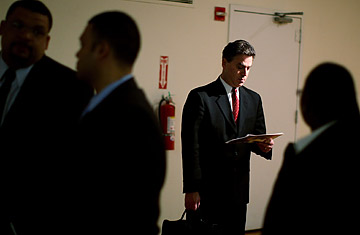
People wait on line to speak with job recruiters on at the New York City Career Fair April 2, 2009 in New York City.
Another month, another 600,000-plus jobs gone. That was the big message from the March employment report released Friday by the Bureau of Labor Statistics, which saw nonfarm employment drop by 663,000 and the unemployment rate rise to 8.5%.
This was the fourth straight month with job losses greater than 600,000. In fact, the biggest news in the report may have been the sharp upward revision to January's job losses (originally reported as 598,000) to 741,000, the biggest one-month decline in absolute terms since 1949. Job losses from this recession are now markedly worse than those during the previous two downturns that had competed for the title "worst since the Depression." Nonfarm employment has dropped by 5.1 million, or 3.7%, since its peak in December 2007. In the 1981-82 recession, employment fell 3.1%, and in 1974-75 it fell 2.8%. (Here's the comparison in chart form.)
In case you're wondering, during the Great Depression, nonfarm employment fell 33.9%, so we're not even remotely close to that territory yet.
The unemployment rate is still well below the 10.8% peak of late 1982, but this doesn't signify much. The rate is what economists call a "lagging indicator," and it will still be rising well after the economy has started growing again. It's also misleading, in that it excludes from its calculations people who would really like to have a job but have given up actively looking. As a result, economic forecasters tend to look more closely at payroll data, which come from a survey of 150,000 businesses and government agencies. (The unemployment rate is derived from a Census Bureau survey of 50,000 households.)
The payroll number is a "coincident indicator": it tells what's happening now, or at least what was happening in the very recent past. It sometimes misses incipient upturns, because new jobs are created by small businesses, which aren't counted in the payroll survey. But there are no signs that anything like that might be happening now. (Read "How to Know When the Economy Is Turning Up.")
There have been some economic reports in recent weeks suggesting that the pace of the downturn has eased: consumer spending has stopped falling, the housing market has begun showing some signs of bouncing along a bottom (not so much in prices yet as in sales volume), and manufacturing's free fall has moderated somewhat. The stock market has of course been on a tear, with the S&P 500 index up 20% since early March. But while the market is a leading indicator, it can be an extremely unreliable one.
The March employment data make it clear that any slowing in the rate of economic decline has yet to make itself apparent in the job market. The payroll drop was at least not any worse than forecasters expected, and it was 78,000 less than January's decline. But given the margins of error in the data, this may not mean anything at all.
The positive take, if you can call it that, is that we're in a "rolling recession," as Kurt Karl, chief U.S. economist at insurer Swiss Re, said in a note to clients. "First the housing market tanked, then consumer spending plummeted, now business investment is nose-diving." Hey, at least it didn't all happen at once! Peter Morici, an economist at the University of Maryland's Smith School of Business, offered a gloomy scenario: "Lacking confidence that the demand for what Americans make and sell will recover significantly anytime soon, businesses are girding for a long siege — slashing employment and dividends and hunkering down," he wrote in an e-mail. "They are preparing for a depression and the eclipse of American leadership."
See which businesses are bucking the recession.
